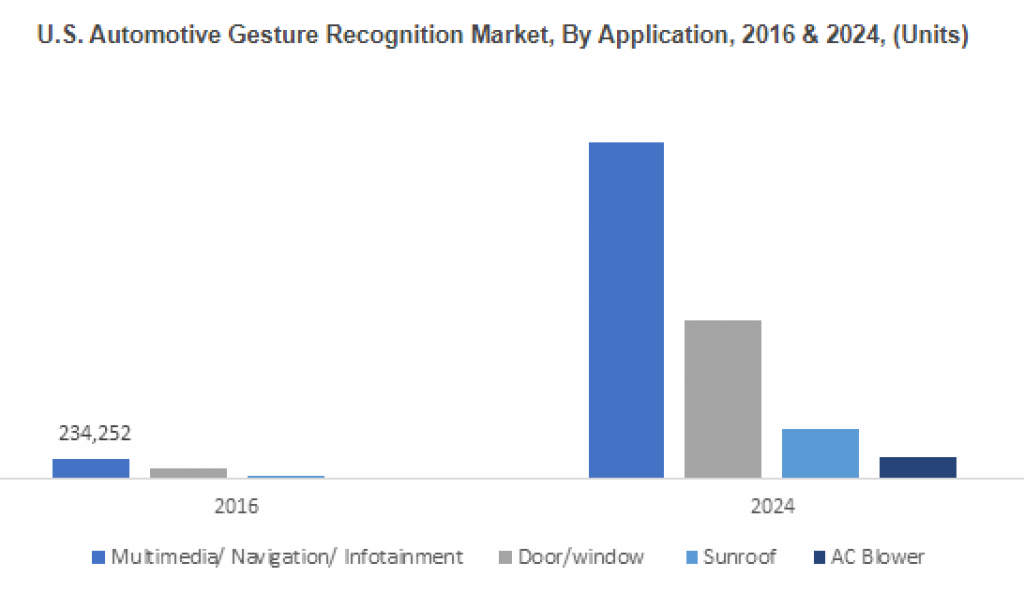The automotive gesture recognition market size is estimated to surpass USD $13B by 2024, according to a new research report by Global Market Insights, Inc.
The automotive gesture recognition market will exhibit over 42% CAGR from 2017 to 2024. A high consumer preference towards application-based vehicle technologies, coupled with rising awareness regarding driver safety, will stimulate the revenue generation over the forecast timeframe. Increasing electronic components and sensors in vehicles will further support the adoption of these systems. In addition, drivers will be able to access multiple vehicle features without losing control on the steering wheels.
Driver safety regulations by various governments have boosted the adoption of automotive gesture recognition systems, due to benefits such as improved maneuvering control, compatibility of vehicle’s electronic systems and drivability. However, the high cost of integration and complexity may limit their adoption, hampering the automotive gesture recognition market growth. Manufacturers are investing heavily for upgrading the existing gesture recognition technology with advanced sensors, resulting in increased costs, further posing a threat to the industry growth.
Passenger cars will dominate the automotive gesture recognition market, generating a demand for over 32 million units over the forecast timeframe. Rising demand from infotainment, navigation and multimedia features in the vehicles will stimulate the industry penetration. Surging demand for medium and high-end passenger vehicle across the globe, along with shifting customer preference towards highly advanced variants in given vehicle range, will further boost the automotive gesture recognition market from passenger cars. Heavy commercial vehicle manufacturers are less likely to adopt these systems owing to less proximity of vehicles in public utilities.
With technological advancements in sensor technology, the automotive gesture recognition market is expected to observe exponential growth rate over the forecast period. In 2016, BMW introduced gesture recognition in its 7- series cars. This model is among the best-selling cars across the globe. Surging demand for electric vehicles will further provide stable growth prospects to the automakers and technology providers.
Touch-based systems accounted for maximum automotive gesture recognition market share, crossing USD $550M in 2016, and will continue to dominate over the next eight years. This can be credited to high preference owing to their strong prevalence over the past years. Automotive gesture recognition touchless systems will exhibit substantial growth, exhibiting around 44% CAGR till 2024, owing to the advanced features and enhanced user experience delivered by these systems.
Hand/fingerprint authentication is estimated to be the fastest growing segment in the automotive gesture recognition market, exhibiting over 43% CAGR from 2017 to 2024. Its growth is credited to technological advancements in touch sensing along with increasing usage of time of flight (ToF) sensors. Safety regulations focusing on driver safety will boost product demand. Vision/iris is likely to grow significantly, witnessing more than 41% CAGR owing to rising interest of manufacturers and customers towards installation of these systems.
Multimedia/navigation/infotainment application in the automotive gesture recognition market is anticipated to acquire the maximum share of more than 60% by the end of 2024. Automobile OEMs are focusing on improving the customer experience with infotainment and navigation systems, primarily driving the demand. Driver distraction can be reduced with easy operability of multimedia in the car with gesture control, supporting the growth of the segment. Growth of the door/window opening segment is attributed to vehicle manufacturers focusing on delivering improved functional features in the vehicles. Moreover, increasing driver control over the vehicle to ensure safety will stimulate the demand for the segment.
Europe is anticipated to dominate the automotive gesture recognition market, crossing USD $6B over the next eight years. The high penetration of premium cars such as BMW 5 and 7 series across the region is expected to primarily support the regional dominance. An established automotive industry with substantial vehicle production is likely to further propel the revenue generation. The North America automotive gesture recognition market will exhibit more than 40% CAGR from 2017 to 2024, owing to rising demand for these systems across the region. This high demand is credited to rising R&D investments by OEMs and shifting consumer preference towards advanced vehicle features.
Qualcomm Technologies Inc., Continental AG, Visteon Corporation, Harman International, and Cognitec System GmbH are among major companies in automotive gesture recognition market. Other prominent vendors include Gestigon Gmbh, Synaptics Incorporated, Softkinetic International SA, Eyesight Technologies, NXP Semiconductors, and Neonode, Melexis and Jabil. The industry is dominated by a few established players, competing to acquire maximum share. The high growth potential of automotive gesture recognition market will invite new participants, thereby intensifying the competition. Large players are focusing on acquiring or investing in small companies to gain access to latest technologies and increase their foothold.
For the full version of this report, please visit the Global Market Insights website.


